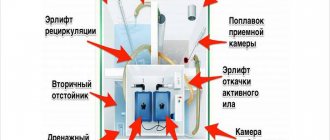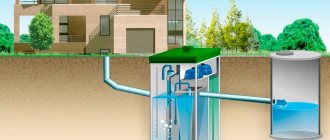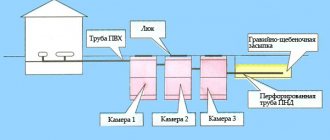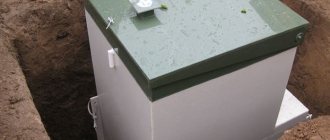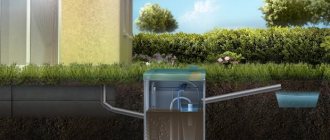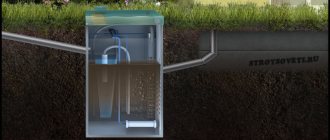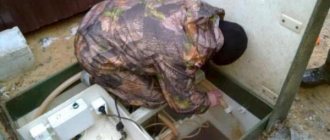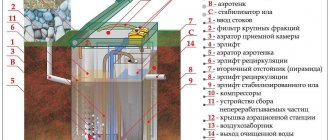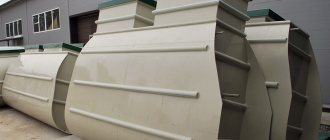Design and principle of operation of Topas septic tanks
The range of domestic septic tanks Topas is extensive. There are both inexpensive options with low productivity for a summer residence, as well as powerful stations for large cottages and even villages. Externally, they all look like a box 2.5–3.1 meters high, closed on top with a lid.
The body of this VOC is made of composite polypropylene, which is resistant to the aggressive environment inside and temperature changes outside. It is, of course, not as durable and frost-resistant as clinker tiles for facades, but in winter this plastic will definitely not crack in the ground. Moreover, the temperature inside the operating station is always naturally maintained in the positive zone.
Topas station design diagram
A - Receiving chamber
1 - Input of drains
- 2 — Coarse filter
- 3 - Main pump
- 9 - Float sensor
- 16 — Aerators
B - Aerotank
- 5 — Aero tank pump
B - Secondary settling tank
- 8 - Output of purified water
G - Sludge stabilizer
- 4 – Sludge pump
D - Compressor compartment
- 6 - Compressors
The internal space of the Topas septic tank is divided into five compartments:
- Wastewater collection chamber with a filter for large fractions.
- Aerotank with aerobic bacteria.
- Settlement tank for final clarification of water.
- Sludge storage tank.
- Compression compartment with pumping equipment.
According to the principle of operation, septic tanks of the design in question resemble a classic three-chamber treatment station. First, primary clarification of wastewater from the house sewer is provided, and then it is treated aerobically. Then they go to the settling tank. From the latter, already purified water is discharged outside for infiltration into the ground or watering green spaces on a personal plot.
Sewage operation diagram
The wastewater enters the first chamber of the Topas septic tank through a pipe with holes in the walls. This coarse filter retains large organic and inorganic fractions so as not to interfere with the operation of other compartments. After initial clarification, wastewater is pumped into the second chamber using a pump, where the main fermentation cycle takes place in the septic tank. Then the 70–80% purified wastewater is pumped into the settling compartment. In this case, the activated sludge is sent to its special storage tank.
Scheme of the principle of working with a drainage well
From the final settling tank, completely fermented and filtered wastewater comes out, suitable for use on the farm for irrigation and technical needs. The result of the work of septic tanks under the Topas brand is process water with a purification degree of around 98%. It is difficult to achieve more when processing sewage from domestic sewerage.
How is wastewater treated?
To understand how a topas septic tank works and what cleaning mechanisms work in each chamber, you should familiarize yourself with the operation of each container in more detail.
Receiving chamber
Here the wastewater is mixed and cleaned of undissolved debris using a filter. This is the largest chamber in terms of volume, where the process of aerobic wastewater treatment begins. Due to the characteristics of aerobic bacteria, it is necessary to exclude the possibility of food waste, household chemicals based on chlorine and alkali, and machine oils entering the station. After filtering the undissolved waste, the homogeneous mass is transferred using an airlift to an aeration tank.
Active aeration chamber
In the air tank, waste is actively mixed using compressed air, which is supplied from the bottom of the tank through a compressor. Mixing and saturating wastewater with oxygen promotes its rapid processing by aerobic bacteria. As the air tank is filled, partially processed waste from it is transferred to the post-treatment chamber with activated sludge.
Activated sludge cleaning chamber
Activated sludge is a specific suspended mixture formed from biological substances processed by bacteria, which actively binds undissolved suspended impurities and completes their processing. The process is completed in the next chamber.
Sludge stabilizer
In this container, the wastewater settles, the sludge settles to the bottom, and clean process water, as it accumulates, is discharged from the station by a drainage pump or by gravity. The degree of purification allows it to be discharged without further purification with soil directly into the drainage ditch.
Topas modifications
The modifications offered by the manufacturer of Topas septic tanks differ in the number of people for which the station is designed and in the depth of the structure. The first parameter in the VOC brand is indicated by the number - 4, 5, 6, 8 and so on up to 150. Moreover, models for 100 and 150 people have a double-hull design. It’s no longer possible to fit everything in one building.
Based on the depth of installation of the Topas septic tank, they differ in:
- “Standard” is a standard solution;
- “Long” – with an elongated neck;
- “Long Us” – with a neck and a reinforced body for its possible extension.
An example of modifications to a Topas-8 septic tank
In the first case, the sewer pipe for insertion into the septic tank is laid at a depth of 40–80 cm, in the second it can be buried at 80–140 cm, and in the third at 140–240 cm. These figures are extremely important to consider when choosing a model. When figuring out how to properly make a sewer system for a private home, many novice craftsmen often focus only on the groundwater level, forgetting about the level of soil freezing.
If Topas is installed in a warm region, then the standard design is optimal. But for a home in Siberia you should only take the option with a neck. The sewer pipe in the area from the home to the septic tank is the most problematic place. This is where the sewage system most often freezes and simply stops working.
Table of modifications of Topas stations, designed for 4 to 9 users
| Model | Human | Reset, l/h | Production, m3/day | Power, kW/day | Weight, kg | LSHV, m |
| Topas 4 | 4 | 175 | 0,8 | 1,5 | 215 | 0,95/0,97/2,5 |
| Topas 4 PR | 4 | 175 | 0,8 | 1,5 | 225 | 0,88/0,97/2,6 |
| Topas 5 | 5 | 220 | 1 | 1,5 | 280 | 1,15/1,17/2,5 |
| Topas 5 PR | 5 | 220 | 1 | 1,5 | 295 | 1,08/1,17/2,6 |
| Topas 5 Long | 5 | 220 | 1 | 1,5 | 340 | 1,18/1/3,1 |
| Topas 5 Long PR | 5 | 220 | 1 | 1,6 | 350 | 1,6/1/3,1 |
| Topas 6 | 6 | 250 | 1,15 | 1,5 | 280 | 1,15/1,17/2,55 |
| Topas 6 PR | 6 | 250 | 1,15 | 1,6 | 295 | 1,08/1,17/2,6 |
| Topas 6 Long | 6 | 250 | 1,15 | 1,5 | 345 | 1,18/1/3,1 |
| Topas 6 Long PR | 6 | 250 | 1,15 | 1,6 | 355 | 1,16/1/3,1 |
| Topas 8 | 8 | 440 | 1,5 | 1,5 | 350 | 1,63/1,17/2,5 |
| Topas 8 PR | 8 | 440 | 1,5 | 1,6 | 365 | 1,56/1,17/2,6 |
| Topas 8 Long | 8 | 440 | 1,5 | 1,5 | 425 | 1,52/1,16/3,1 |
| Topas 8 Long PR | 8 | 440 | 1,5 | 1,6 | 435 | 1,5/1,16/3,1 |
| Topas 8 Long US | 8 | 440 | 1,5 | 1,5 | 490 | 1,69/1,36/3,1 |
| Topas 8 Long PR US | 8 | 440 | 1,5 | 1,6 | 495 | 1,66/1,36/3,1 |
| Topas 9 | 9 | 510 | 1,7 | 1,5 | 355 | 1,63/1,17/2,55 |
| Topas 9 PR | 9 | 510 | 1,7 | 1,6 | 370 | 1,56/1,17/2,6 |
| Topas 9 Long | 9 | 510 | 1,7 | 1,5 | 420 | 1,52/1,16/3,1 |
| Topas 9 Long PR | 9 | 510 | 1,7 | 1,6 | 430 | 1,5/1,16/3,1 |
| Topas 9 Long US | 9 | 510 | 1,7 | 1,5 | 460 | 1,69/1,36/3,1 |
| Topas 9 Long PR US | 9 | 510 | 1,7 | 1,6 | 470 | 1,66/1,36/3,1 |
PR - has a built-in pump, US - reinforced, Long - extended neck
Model range and technical characteristics
Septic tank Topas 5 contains several modifications. Each device is designed for constant, continuous operation. Septic tank Topas 5 can do an excellent job of treating wastewater coming from the toilet, shower, plus two sinks. Models of the Topas 5 biological septic tank are presented below, and their photos can be viewed on our website.
| Name/modification | Length | Width | Height | Weight (in kg) | Power consumption (kW per day) |
| Septic tank mod. Topas 5 Long Pr | 1 m 10 cm | 1m 20 cm | 3 m 10 cm | 310 | 1,5 |
| Septic tank mod. Topas 5 Long | 1 m 10 cm | 1m 20 cm | 3 m 10 cm | 300 | 1,5 |
| Septic tank mod. Topas 5 Pr | 1 m 10 cm | 1m 20 cm | 2 m 60 cm | 260 | 1,5 |
| Septic tank mod. Topas 5 | 1 m 10 cm | 1m 20 cm | 2 m 50 cm | 250 | 1,5 |
As can be seen from the table presented, the dimensions of the septic tank are quite small, so the owner of the station can easily determine it anywhere. Septic tank Topas 5, its variety Topas 5 Pr and the rest on average process up to 1 cubic meter per day. m of wastewater, while the one-time discharge of this water should not amount to 220 liters.
The technical characteristics of the models are as follows.
Topas 5 is a septic tank made of polypropylene. In addition to the high strength of the material, it has anti-corrosion properties and high resistance to deformation. The sewer pipe is connected to the station at a depth of about 80 cm, so this unit is ideal for the south of the country or for seasonal use in gardens and summer cottages. The depth of the pit for installation of the Topas 5 septic tank, in accordance with the instructions, should be 2500 mm.
Topas 5 Long is a biological septic tank designed for a sewer pipe that will run deeper. The depth of laying this pipe to the Topas 5 Long septic tank is 800-1400 mm. The deep passage of the sewer pipe underground allows the use of a septic tank in winter. According to the technical characteristics, a pit with a depth of three meters is required for the purpose of installation, high-quality and correct installation of Topas 5 Long.
Topas 5 Pr is a partially similar septic tank, with forced drainage of water. It is used in areas with groundwater where gravity flow is difficult. Additionally, Topas 5 Pr is equipped with a drainage pump located in a special chamber. The sewerage system, according to the instructions, is connected at a depth of 40 cm to 80 cm. The depth of the required pit for installing the Topas 5 Pr septic tank and its installation is 2500 mm.
Topas 5 Long Pr is a septic tank that combines the excellent technical characteristics of the Topas 5 Long station discussed above, as well as the station of the Topas 5 Pr model. The depth of installation and insertion of the sewer pipe is 800-1400 mm, the extended neck, the possibility of year-round operation, he inherited from the first. From the second, this biological septic tank received a special chamber with a drainage pump for forced pumping out of processed waste. The required pit depth for installation and installation of Topas 5 Long Pr is 3 meters.
Advantages and disadvantages of the Topas septic tank
The advantages of the Topas septic tank are as follows:
- Processing of all types of household waste;
- Easy installation of a septic tank without concreting the base;
- No need to frequently call vacuum cleaners;
- Minimum occupied space on the site for “Topas”;
- High degree of purification of 97–98%;
- No unpleasant aroma;
- Possibility of year-round use;
- Possibility of installing sewerage even in winter.
Space on the site near the house for a Topas septic tank, designed for 3-4 people, requires about 1-2 square meters. He doesn’t need to call a sewer truck. A couple of times a year, sludge needs to be pumped out of this treatment plant. But you can do this yourself. At the same time, the sludge mass obtained as a result of the operation of the septic tank, after composting, turns into an excellent fertilizer, ideal for garden beds.
Among the disadvantages of operating a Topas septic tank, the following should be mentioned:
- The need for regular maintenance of compressors;
- Restrictions on salvo discharge;
- Dependence on electricity supply.
Each Topas VOC model has its own limitation on the one-time flow of wastewater. The first chamber is designed only for a strictly defined volume of water. If more sewage is released into the house sewer in two hours, then this compartment simply will not be able to handle it.
If there is a long power outage, problems may even begin. The operating principle of these septic tanks is based on constantly turning on/off pumps to pump wastewater from one chamber to another and supply oxygen to aerobic bacteria. If there is no electricity for more than a day, the degree of purification will drop and the outlet water will become cloudy.
Advantages
Among the advantages that septic tanks of the entire Topas line have, several main ones can be distinguished:
- Purification efficiency - the output is 98% purified water, which can be used for irrigation or discharged into open water bodies.
- Compactness - the Topas septic tank is slightly larger in size than a refrigerator, due to this it will not take up much space on the site.
- Easy installation - you can install the station yourself.
Service
For the first service, it is advisable to invite a specialist from the seller’s company, he will carry out the service and advise further actions. In the future, you can do this yourself. This does not require special knowledge or a lot of time. To do this you will need:
- Clean the debris filter once a month;
- clean the sludge receptacle once a quarter;
- replace membranes in compressors every two years;
- replace the aerator after 15 years.
Installation and maintenance of septic tanks
Installation of TOPAS sewerage is carried out according to the following scheme:
- A pit is dug in width and length 30–40 cm larger than the dimensions of the body of the selected model. Its depth is 10 cm greater than the height of the station. These centimeters are needed to install a cushion of compacted sand at the bottom of the pit.
- A septic tank is installed in the pit. Next, a sewer pipeline from the house with a slope of 2 degrees and a power cable are connected to it.
- The trench with the pipe and the pit with the treatment station are backfilled.
We lower the station into the pit
The earth is filled in so that only the lid is visible on the surface. There is no need to pour a slab foundation under this septic tank as an anchor. Even a low-power Topas model for 3-4 people weighs more than 200 kg. Plus, a lot of waste is added to this. This station will be able to float only in case of very strong flooding and flooding of everything around.
Only the lid remains on the surface
We dig a trench to the septic tank
We crash the pipe into the septic tank
We seal the entrance of the pipe to the septic tank with a special hairdryer and tape.
Burying sewer pipes
We make a hole in the same way and seal it for water outlet
We connect the septic tank to the electrical network
The Topas septic tank is suitable for any dwelling, be it country houses, two-story brick townhouses, or small frame-panel houses. There are restrictions only on the number of residents and the one-time volley discharge of wastewater. But here you just need to choose the station option wisely.
Maintenance of VOC Topas comes down to removing large fractions from the filter in the first chamber and excess sludge from the storage tank. For this purpose, a special pump is provided, which must be turned on as the need arises.
This septic tank is installed with your own hands, and then operated without any problems. To confirm this, just watch a video with reviews from those who are already using it. There is not a word about any difficulties. In terms of ease of installation, it resembles the laying of flexible tiles, which even a non-professional can handle.
Service
To avoid breakdowns of the Topas 5 biological septic tank and its subsequent repair, you need to draw up an appropriate agreement with a service organization, the price of services varies everywhere, you will need to look for the best offer. Its specialists will monitor the operation of the station and take timely measures to ensure that its work is not stopped, and will also ensure the conservation of the Topas 5 septic tank for the winter and carry out the necessary cleaning.
This will also allow the septic tank to operate for a longer period. But in case of financial difficulties, it is quite possible to carry out servicing and cleaning of the septic tank yourself. But you will need knowledge of what work is performed and when.
The filter element that retains hard parts must be cleaned quarterly and the leveled sludge must be removed. At the same time intervals, the airlift is cleaned, the side surfaces of the station are cleaned, and the pump is checked and tested.
Approximately every couple of years, the membranes located directly in the compressor, through which oxygen is supplied to the septic tank, are replaced.
Aeration elements can be replaced 12 years after the septic tank has been commissioned.
The septic tank maintenance process begins with cleaning those parts and elements to which the home owner has easy access. Having completed this work, you will need to remove the airlift tubes, for which you first heat them with a hair dryer. The coarse particle filter is removed and cleaned in the same way. These septic tank elements are cleaned with water, preferably running water. Then the airlift (pump) and filter are put back, and the air tubes are connected.
Then you need to use a pump to pump out the sludge from the depths of the septic tank. It should be pumped out to 2/3 of the volume. The stabilizer is filled with clean water. You also need to remember to thoroughly clean the so-called comb, which serves as a filter to retain non-recyclable particles. It is advisable to carry out such maintenance before preserving the autonomous sewer system for the winter.
Using Topas septic tanks for home and garden
If you need an autonomous domestic sewage system, then the Topas septic tank is ideal for organizing it. No wonder he is so popular in Russia. It is placed both in dachas with irregular residence and near village houses where a family of several people lives all year round. The design of this treatment station is extremely simple. Any owner of a country cottage can handle installation work and maintenance.
Exterior view of the Topas septic tank on the site
Methods for draining drainage in Topas septic tanks
Topas stations can be gravity flow or with forced drainage. Gravity flow ones are installed in dry soil with a low groundwater level. Water can be discharged into a filter well, onto a steep slope or into a deep ditch (from 80 cm in depth). Water drainage from the station is forced if there is clay and/or high groundwater level on the site.
Important! The water coming out of the station is warm, so in winter the discharge onto a slope or into a ditch does not freeze.
The Topas septic tank with forced drainage of wastewater has a pre-installed pump compartment. It is located in the receiving chamber and is connected to the secondary settling tank by a pipe (Fig. 2). For gravity stations, the outlet is located in the secondary settling tank chamber. During production, the inlet and outlet holes in the body are not cut; they are made by installers when installing a septic tank on site.
Septic tank Topas 4 with forced drainage
The principle of operation of the autonomous sewage system Topas
The operation of the Topas sewerage installation is based on the use of a biological method of wastewater treatment. Aerobic bacteria are used to remove feces from contaminated wastewater. In terms of its implementation, this process is quite simple.
Carrying along organic contaminants, wastewater ends up in a septic tank, for which a pipeline is used to transport it there. Once in the first tank, they encounter active bacteria that begin cleaning. To speed up the decomposition process, oxygen is supplied to the container in a continuous mode, provided by the aeration tank.
Thanks to the supply of oxygen, favorable conditions are created for the accelerated decomposition of feces, fat, and food debris discharged into the sewer system. Using such a system allows you to purify water from contamination by 99% with minimal time. Based on these indicators, it can be stated with a high degree of certainty that the septic tank in question has high environmental characteristics.
In terms of the level of wastewater treatment using the Topas sewer system, full satisfaction of the requirements of current norms and standards is ensured. Using such an installation, you can effectively organize a full cycle of wastewater treatment. It is worth noting that during wastewater treatment, which takes place directly in the installation itself, the interaction of water with the surrounding space is eliminated.
Tips for using the Topas 5 septic tank
In order for a septic tank to effectively purify wastewater for a long time, you must follow the rules of the operating instructions:
- make sure that aggressive substances in the form of acids, alkalis, alcohol, drugs do not penetrate into the system, as this can lead to the destruction of bacteria;
- It is prohibited to throw rotten food into the sewer system, as this may cause problems with the septic tank;
- If there is a power outage, the amount of water discharged must be minimized. If the container is overfilled with dirty waste, it will eventually end up on the site;
- it is necessary to ensure that a minimum amount of sand and soil gets into the drains. If there are substances of inorganic origin in the system, this may impair the efficiency of its operation;
- it is very important to regularly carry out maintenance of the cleaning system , the main activities of which boil down to replacing filters and other key elements.
Among the sewerage treatment systems offered on the market today, one of the most preferred options is the Topas septic tank. Such installations are intended for servicing country houses, where they do an excellent job. The effectiveness of their work is largely due to the presence of a large number of advantages.
When using such an autonomous system, you can guarantee a high level of wastewater treatment , which turns into water that meets all the requirements of environmental standards. Water treated in this way can be used in the household, which will not be associated with any health risks. The sludge that collects at the bottom of the tank is also used. This substance can be used as an excellent fertilizer. Video instructions for using a Topas septic tank, available on many websites, allow you to get a detailed understanding of the operating principle of the cleaning system and make the right choice.
